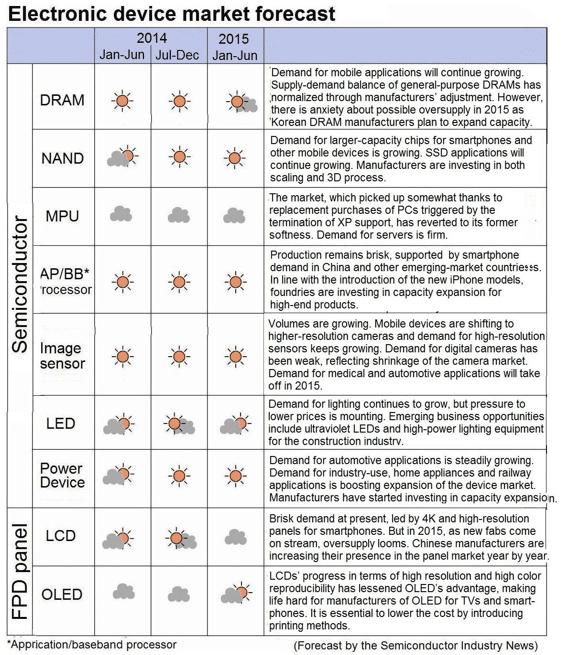Trend: Electronic device market forecast—Clear skies continuing thanks to smartphones and automotive demand
Demand for smartphones and other mobile gizmos is booming and motor vehicles are packed with more and more electronic gear. With these two big applications to the fore, robust growth of the semiconductor and display markets is in prospect for 2014 and 2015.
Though no looming storm clouds threaten this sunny outlook, the semiconductor industry would be well advised to explore new sources of demand capable of picking up the slack once everyone and his dog has a smartphone.
So brisk is the semiconductor market that several influential research firms and industry associations have revised their forecasts upward. In July, for example, Gartner revisited its semiconductor market forecast for this year, changing the previously announced 5.4% growth to 6.7%, which would give a global market worth 336 billion dollars.For its part, WSTS embraced the optimistic mood, revising its forecast for this year's semiconductor market to 6.5% in April, up from the 4.1% growth predicted last autumn.
Smartphones
Smartphones along with other mobile devices are the major driving force of the semiconductor market. All the indications are that 1.2-1.3 billion smartphones will be shipped this year, 20% more than last year, outnumbering PCs almost 4 to 1.
Rip-roaring smartphone demand in China, fueled by the rollout of LTE services, accounted for the lion's share of semiconductor market growth in the first half of this year. In the second half, the iPhone 6 and 6 Plus, introduced in September, are stoking demand for chips and electronic components. Smartphone demand in China is catching its breath because of excessive inventory, but is expected to rebound from around October as the New Year sales season comes into view.
Automotive applications
Automotive applications have emerged as a pillar of the semiconductor industry. Annual global automobile production, having already topped 80 million units, may soon break the 100-million barrier. Even as the number of motor vehicles soars, the quantity of semiconductors per vehicle is sharply increasing, boosting demand for chips.
The take-up of HEVs and other green cars coupled with the introduction of advanced driving assistance systems (ADAS) is expected to ignite semiconductor demand as more sensors, microcontrollers and power devices are sucked into automotive applications.
Memories
Demand for both DRAM and NAND is firm. While DRAM demand from PC manufacturers has been soft, more DRAMs are going into mobile devices as well as into servers, and so the DRAM market is growing at a healthy pace.
In the first half, there was a blip in NAND demand due to inventory adjustment, but the market has been vigorous since May, led by smartphone demand. Leading manufacturers are investing in capacity expansion.
Logic LSIs
Demand for system-on-chip LSIs, including application processors for mobile devices, keeps growing. In China, the introduction of LTE services has spurred smartphone vendors' demand for logic LSIs using advanced 28nm-class processes. Foundries supplying these LSIs have achieved high yields.
Display panels
The display panel market is growing at a reasonable pace. Manufacturers are busy satisfying rising demand for higher-resolution panels, such as 4K panels for TVs, and WQHD panels for smartphones. As larger panels are in demand, plant utilization rates are high, a trend that should continue for a while. Manufacturers' profitability hinges on how deft they are at striking a healthy balance between orders for small/mid-size panels, which tend to command high prices, and panels for TVs, which are subject to steep price erosion.
OLED
Whereas demand for LCD panels has been boosted by the growing appetite for higher-resolution panels, OLED panels are lagging LCDs in terms of resolution and their higher production cost. The appeal of OLED panels' high color reproducibility, formerly one of their key advantages, is fading with the emergence of quantum dot materials for LCDs.
Panel flexibility remains a powerful feature of OLED. Demand, however, is still unclear as it depends on whether new applications, such as Apple's iWatch, take off.
Thinness is the decisive differentiating attribute of OLED panels. To exploit this attribute for competitive advantage in the display market, manufacturers need to establish low-cost production systems by introducing printing methods. Now is the time for OLED manufacturers to establish their potential.
The brisk LCD market at present, however, may run into turbulence next year. Many LCD fabs are now under construction in China. Once these new fabs come on stream, oversupply is a distinct possibility. Manufacturers need to cultivate demand for high-resolution panels, for such new applications as medical equipment, while endeavoring to raise the unit value by developing and offering high-performance modules.
The original article in Japanese appeared in the Sept. 9 issue of The Semiconductor Industry News. Translation by EmergingTech, which added the links.
Related articles:
Trend: Electronic device market forecast—Good climate, bad weather (Jan. 15, 2014)
Trend: Smartphone-driven demand for components getting cloudy, post-smartphone demand wanted (Sept. 27, 2013)
Warning: Invalid argument supplied for foreach() in /home2/semicon/hosting/spiwww/include/Banner.php on line 78
Warning: array_multisort(): Argument #1 is expected to be an array or a sort flag in /home2/semicon/hosting/spiwww/include/Banner.php on line 81
Warning: Invalid argument supplied for foreach() in /home2/semicon/hosting/spiwww/include/Banner.php on line 85




